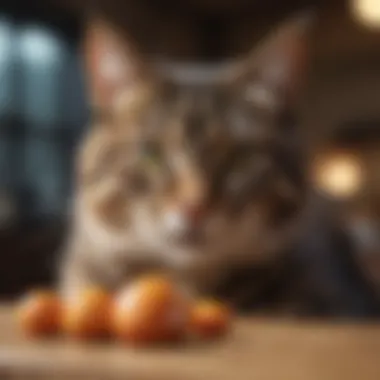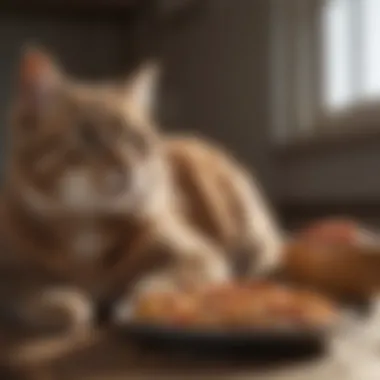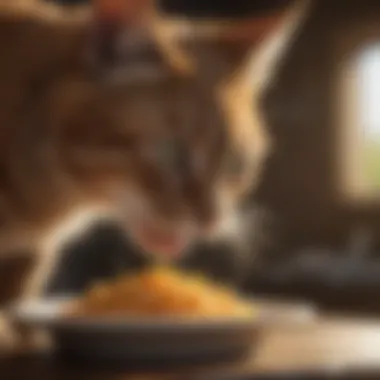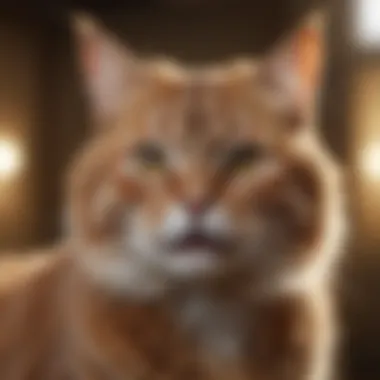Nutritional Strategies for Healthy Weight Gain in Cats


Intro
Understanding the nutritional needs of cats is crucial, especially when faced with underweight issues. Cats, known for their grace and agility, often present unique dietary challenges. It’s not just about feeding them; it’s about ensuring that the food aids in healthy weight gain without compromising their overall well-being.
Fascinating Facts About the Animal
Unique Characteristics
Cats are obligate carnivores, meaning their diet must primarily consist of meat. They have evolved to thrive on high-protein diets with moderate fat levels. Essential nutrients such as taurine, arachidonic acid, and vitamins A and B12 are vital for their health. Their unique anatomy, including a specialized digestive system, allows them to process animal protein effectively.
Extraordinary Abilities
Felines possess exceptional hunting skills. Their keen sense of smell and sharp eyesight allows them to detect prey even in low light. These characteristics are not just for survival; they influence their behavioral patterns and dietary preferences. Understanding these traits helps in selecting appropriate dietary strategies for weight gain.
"Cats can make unique dietary adjustments that reflect their physical condition and environment."
Nutritional Requirements for Weight Gain
To effectively address the issue of underweight cats, one must recognize their specific nutritional requirements. A higher caloric intake is essential for promoting weight gain.
- High-Quality Proteins: Include chicken, turkey, and fish in their diet. These options provide essential amino acids.
- Fats for Energy: Incorporating healthy fats, such as fish oil or chicken fat, can provide additional calories needed for weight gain.
- Digestive Health: Opt for foods with probiotics to enhance gastrointestinal health, leading to better nutrient absorption.
Appropriate Food Selections
When selecting cat food, consider both dry and wet food options.
- Wet Food: Often higher in calories and moisture, making it an ideal choice for underweight cats. Brands like Hill’s Science Diet or Royal Canin offer specialized formulations.
- Dry Food: Can be energy-dense, but ensure it contains adequate protein and fat. Look for formulations designed for weight gain or high-performance formulas.
Effective Feeding Strategies
Feeding strategies can significantly impact the success of weight gain.
- Frequent Small Meals: Offer multiple small meals throughout the day rather than relying on one or two larger portions. This method encourages increased caloric intake without overwhelming the cat’s digestive system.
- Treats for Weight Gain: Healthy treats can provide additional calories. Look for options high in protein, such as freeze-dried meat treats.
- Monitoring Weight Progress: Keep track of your cat’s weight and adjust feeding strategies accordingly. Regular visits to the veterinarian can ensure that the weight gain is within a healthy range.
Ending
Understanding the dietary needs of cats is essential for those looking to increase their weight. By recognizing their unique characteristics, focusing on high-quality protein, and implementing effective feeding strategies, you can support your cat’s health and enhance their quality of life.
Understanding Feline Weight Dynamics
Understanding weight dynamics in cats is crucial for several reasons. It connects directly to their overall health, emotional well-being, and longevity. When a cat maintains an appropriate weight, it usually reflects a balanced diet and a suitable lifestyle. Conversely, fluctuations in weight can indicate underlying health issues, especially in underweight cats. This section explores pivotal components that influence feline weight, offering insightful knowledge for pet owners and veterinarians alike.
The Importance of Maintaining a Healthy Weight
Maintaining a healthy weight for your cat is vital for its overall health and longevity. Cats that are at their ideal weight have a lower risk of developing serious health issues such as diabetes, arthritis, and cardiovascular diseases. Additionally, a proper weight ensures that a cat can engage in normal activities and behaviors without undue strain.
Several benefits come with keeping a cat within a healthy range:
- Improved Mobility: Cats at their ideal weight can jump and play more easily.
- Increased Lifespan: Healthy-weight cats tend to live longer than those who are overweight or underweight.
- Better Quality of Life: An appropriate weight allows cats to enjoy their life more fully, including play and interaction with humans.
Common Causes of Weight Loss in Cats
Weight loss in cats can occur due to various reasons, many of which require immediate attention. Understanding these causes helps in addressing the issue early.
Some common reasons include:
- Illness: Conditions such as hyperthyroidism, kidney disease, or cancer can lead to significant weight loss.
- Dental Problems: Painful dental issues may reduce a cat's appetite, affecting its weight.
- Stress: Changes in environment or routine may lead to stress-induced weight loss.
- Nutritional Deficiencies: Inadequate diet can hinder weight gain and result in loss.


It’s essential to investigate these potential causes thoroughly. If a cat is losing weight without obvious reasons, it's advisable to consult a veterinarian to rule out serious health conditions.
Weight management is a balance of nutrition, activity, and monitoring health.
Nutritional Requirements for Weight Gain
Understanding the nutritional requirements for weight gain is crucial when addressing the issues of underweight cats. Proper nutrition targets the specific needs of felines and supports their overall health while promoting healthy weight gain. This section examines how caloric intake and essential macronutrients contribute to achieving these objectives.
Caloric Needs of Cats
Cats are obligate carnivores. This means their bodies primarily require meat-based nutrients, leading them to have unique caloric needs. To promote weight gain, a higher caloric surplus must be established in their diets. Generally, an average adult cat needs between 20 to 30 calories per pound of body weight per day for maintenance. However, for weight gain, this number may need to increase.
- Age: Kittens and young cats have higher energy requirements compared to older cats.
- Activity Level: More active cats may burn calories faster, necessitating increased intake.
To determine an individual cat's caloric needs accurately, monitoring its activity level, weight, and health condition is essential. Regular adjustments based on these factors can help create a tailored feeding plan conducive to weight gain.
Macronutrients Essential for Weight Gain
Fats
Fats are an essential component of a cat's diet, particularly when it comes to weight gain. They provide an energy-dense source that can significantly increase caloric intake without requiring large volumes of food. Moreover, fats play a vital role in supporting healthy skin, coat, and overall cellular function.
- Key Characteristic: Fats offer more than double the calories per gram compared to proteins and carbohydrates, making them an efficient energy source for cats.
- Unique Feature: Their absorption is relatively fast, providing immediate energy.
However, it is important to select healthy fats, such as omega-3 and omega-6 fatty acids, found in fish oils or flaxseed. While beneficial, excessive fat intake can lead to obesity if not properly managed.
Proteins
Proteins are imperative for a cat's muscle development. High-quality protein sources are fundamental for ensuring that the weight gained is not just fat but also muscle mass. Proteins are broken down into amino acids, which are essential for various bodily functions and repair mechanisms.
- Key Characteristic: Proteins can aid in building lean body mass when combined with adequate physical activity.
- Unique Feature: They stimulate satiety in cats, helping regulate appetite levels amidst increased caloric intake.
When selecting proteins, prioritize animal-based proteins, like chicken or fish. While essential for muscle mass, too much protein without corresponding fats could lead to unnecessary stress on the kidneys.
Carbohydrates
Carbohydrates can serve as a supplemental energy source. Although cats do not require as many carbs as dogs, certain complex carbohydrates can provide beneficial energy while supporting digestive health.
- Key Characteristic: They may contribute to a feeling of fullness, preventing cats from begging for more food.
- Unique Feature: Some carbs can act as prebiotics, promoting gut health.
However, it's essential to ensure that carbohydrates do not make up a significant portion of the diet. Overly processed grains can lead to weight gain but not provide necessary nutrients. Careful choice and portioning are vital.
In summary, a holistic approach to the nutritional requirements for weight gain in cats focuses on balancing calories from fats, proteins, and carbohydrates. Selecting high-quality ingredients ensures that your cat gains weight healthily and sustainably.
Choosing the Right Food
Choosing appropriate food for your cat is critical in the journey to increase their weight. This section discusses important elements of nutrition that align with feline needs. Understanding the nutritional requirements, especially caloric intake, will facilitate effective weight gain strategies. It is not just about filling the bowl; it involves selecting foods that are dense in calories and rich in essential nutrients.
Making informed decisions about the food you offer, alongside your cat's individual preferences, can significantly improve their appetite and overall health. Here are some specific elements to consider regarding high-calorie cat food options.
High-Calorie Cat Food Options
When looking for high-calorie cat food options, it is prudent to focus on the ingredients. Cat food that is rich in protein and fats can have a higher caloric content. Some recommended brands include:
- Royal Canin Calorie Control: This diet is formulated to provide more calories while maintaining optimal nutrients to help cats gain weight healthily.
- Hill's Prescription Diet a/d: This option is ideal for cats recovering from illness or surgery; it provides necessary calories in a softer, more palatable form.
- Purina Pro Plan Veterinary Diets: Known for launching high-protein options, this brand offers several varieties aimed at increasing body mass.
It is essential to read the label for caloric content and ensure that any food you choose maintains a high level of animal protein.
Wet vs.


Dry Food: Which is Better?
The debate over wet versus dry cat food has long been central to feline nutrition discussions, especially for weight gain. Each type has its own benefits. Wet food often has a higher moisture content and may appeal more to cats, which can enhance their food intake. Therefore, it can be an excellent choice for underweight cats. In contrast, dry food can offer high caloric density and be more convenient for storage and serving.
Advantages of Wet Food:
- Higher moisture content.
- Often more flavorful, encouraging consumption.
- Easier to swallow for cats with dental issues.
Advantages of Dry Food:
- Typically lower cost.
- Can be left out for free feeding, which may benefit some cats.
- Some varieties support dental health by whisking away plaque and tartar.
Ultimately, the best approach may combine both wet and dry food, optimizing calorie intake while catering to your cat's tastes. Observing how they respond to each type can guide your decision for an effective diet.
Homemade Diet Plans for Cats
Creating homemade diet plans for cats can be a beneficial way to manage their weight effectively. When done correctly, it allows pet owners to control the quality and quantity of food, ensuring that the cat receives the necessary nutrients for healthy weight gain. This section will explain why these diets can be advantageous, detail safe ingredients to include, and outline harmful foods to avoid.
Safe Ingredients to Include
When developing a homemade diet, incorporating safe, high-quality ingredients is crucial. Here are some suggested ingredients:
- Lean Meats: These form the protein base of your cat's diet. Chicken, turkey, and lean cuts of beef are excellent choices.
- Fish: Salmon and tuna can be appealing options, provided they are offered in moderation and cooked properly. Fish is rich in omega-3 fatty acids, benefiting overall health.
- Cooked Eggs: Eggs are a good source of protein and can be added to meals occasionally for variety.
- Vegetables: Some cats enjoy small amounts of cooked carrots, peas, or pumpkin. These add fiber and nutrients but should be limited.
- Rice or Quinoa: Complex carbohydrates can provide energy. Cooked rice or quinoa helps in building a balanced diet.
Always consult a veterinarian before changing a cat's diet. Each ingredient should be introduced gradually, monitoring for any adverse reactions.
Avoiding Harmful Foods
It is equally important to understand which foods can be harmful or toxic to cats. Here’s a list to consider:
- Onions and Garlic: Both can cause gastrointestinal upset and lead to more severe health issues.
- Chocolate: Even small amounts can be harmful and should be strictly avoided.
- Dairy Products: Many cats are lactose intolerant, so milk and cheese may cause digestive issues.
- Grapes and Raisins: These can lead to kidney failure in some animals, making them extremely dangerous.
- Raw Dough: The yeast in raw dough can rise in a cat’s stomach, causing pain and distension.
- Artificial Sweeteners: Products containing xylitol are toxic to pets and should never be fed to cats.
Always verify the safety of ingredients before including them in your cat’s diet. It helps to conduct thorough research and consult with your veterinarian.
Supplementation and Treats
Supplementation and the use of treats can play a crucial role in a cat's weight gain journey. While a balanced diet is essential, certain supplements can combat nutritional gaps. They can also enhance the overall effectiveness of the dietary strategy in promoting healthy weight gain. Likewise, carefully chosen treats can provide additional calories and nutrients without drastically altering the cat's primary diet.
When to Consider Supplements
Not all cats will require supplements, but they become especially important under certain circumstances. For instance, if a cat is recovering from illness or has a diminished appetite, supplements may provide necessary nutrients that regular food might not. Similarly, elderly cats often experience changes in metabolism and digestive efficiency, making supplementation beneficial.
Careful selection is key. Consult your veterinarian to determine which supplements can complement the current diet effectively. Some may need protein powders or specific vitamins to address deficiencies. Others might benefit from fatty acids like omega-3s, which provide energy and support overall well-being.
Selecting Healthy Treats for Weight Gain
Treats can serve not only as rewards but also as tools to encourage weight gain. However, not all treats are created equal. When choosing treats for an underweight cat, look for options that are high in calories and quality ingredients.
Some favorable examples include:
- High-Protein Treats: Options made from chicken, turkey, or fish can provide both protein and calories.
- Nutrient-Enriched Snacks: Treats formulated with vitamins and minerals enhance the overall diet.
- Soft Treats: These can be easier for some cats to chew and digest, particularly if they have dental issues.
Avoid treats with fillers, artificial flavors, and preservatives. These not only provide little benefit but can also contribute to health issues in the long run. Instead, aim for wholesome, simple formulations that echo the values of a balanced diet. Remember, treats should make up only a small fraction of your cat's total caloric intake, ideally around 10%.
Treats should serve as a positive addition to the diet, supporting your cat’s journey toward healthy weight gain when chosen wisely.
Incorporating appropriate supplements and treats requires careful thought and planning. Their strategic use in a feeding regimen can significantly contribute to a successful and health-focused weight gain strategy.


Feeding Strategies for Weight Gain
Feeding strategies play a critical role when it comes to helping your cat gain weight. Inadequate weight can lead to various health concerns including weakened immunity and lower energy levels. Therefore, a well-structured feeding plan is essential. This section will explore effective approaches to achieve healthy weight gain in your cat, focusing on establishing a dependable feeding routine and incorporating smaller, more frequent meals.
Establishing a Regular Feeding Routine
Creating a feeding routine is one of the cornerstones for promoting weight gain in cats. Regular meal times not only help to build a sense of security and predictability for the feline, but also encourage more consistent consumption of food. Cats thrive on routine. It aids their digestion and can significantly impact their energy levels.
To establish a feeding routine:
- Set specific meal times: Aim for meals at the same time each day. This helps signal when to expect food and can reduce anxiety for underweight cats.
- Monitor portion sizes: Ensure each meal contains adequate calories tailored to your cat’s specific needs. It’s advisable to consult feeding guidelines provided on pet food packaging or reach out to a veterinarian to determine the right portions.
- Limit free feeding: While it may seem convenient, leaving food out all day can lead to grazing and inconsistency in caloric intake. A scheduled approach encourages stronger meal-focused behavior.
By sticking to a routine, many pet owners find that their cats have increased appetites and ultimately gain the necessary weight more effectively.
Incorporating Frequent Small Meals
In addition to establishing a regular feeding routine, incorporating frequent small meals into your cat's diet can also facilitate weight gain. This method can be particularly beneficial for cats that may experience digestive discomfort when consuming larger meals. Small, more manageable portions can reduce the risk of gastrointestinal upset, making it easier for the cat to absorb nutrients effectively.
Some strategies for implementing frequent feedings include:
- Dividing daily food intake: Instead of offering two large meals, consider breaking the total daily caloric requirement into four to six smaller meals. This approach can prevent sluggishness after eating and promote steady energy levels throughout the day.
- Utilizing automatic feeders: If your schedule makes it difficult to feed your cat multiple times a day, automatic feeders can help dispense food at pre-selected times. This ensures timely feedings without requiring your immediate presence.
- Choose calorie-dense food: Opt for higher-calorie foods appropriate for weight gain as these can provide more nutrients in smaller portions, optimizing each feeding.
Frequent small meals often lead to improved overall eating habits in cats, which can be particularly beneficial for those struggling with weight issues.
By implementing these feeding strategies, pet owners can foster a nurturing environment that promotes healthier weight gain in their feline companions. The interplay of regular meal times and smaller, frequent portions can create a holistic approach to managing and improving your cat’s weight effectively.
Monitoring Progress
Monitoring progress is crucial in the journey toward increasing your cat’s weight. It involves tracking changes in weight and making necessary adjustments to the feeding plan. A structured approach here not only helps ensure that your cat is attaining a healthy weight but also prevents potential health problems that may arise from inadequate nutritional intake. Frequent checks enable pet owners to observe patterns and make informed decisions about dietary needs.
Tracking Weight Changes
To effectively monitor your cat’s weight, consistency is key. Weigh your cat regularly, ideally once a week. This frequency allows you to gauge fluctuations and establish a baseline for comparison over time. Use a scale sensitive enough for this purpose, like a digital pet scale. Record your cat’s weight in a notebook or an app.
Consider the following when tracking your cat's weight:
- Consistency in Timing: Weigh your cat at the same time of day each week, preferably before meals.
- Safe Handling: Make sure your cat is calm and relaxed during weight checks. Stress can affect readings.
- Regular Records: Keep a detailed log of the weight to identify any trends. This data is valuable for discussions with a veterinarian.
Consulting with a Veterinarian
Consulting with a veterinarian is a fundamental aspect of monitoring your cat’s weight gain. A veterinarian provides expert advice on appropriate feeding strategies and can identify underlying health issues that might hinder weight gain. They can also suggest specific diet plans tailored for your cat’s unique needs.
When meeting with a veterinarian, consider sharing:
- Weight Tracking Logs: Bring your records to provide a clear picture of progress.
- Dietary Changes: Discuss any changes in food or routine you have implemented.
- Behavioral Observations: Share any changes in appetite or activity level, as these may relate to weight issues.
- Health Concerns: Mention any other health issues that could impact your cat’s weight.
By actively engaging with a veterinarian, you reinforce a proactive approach to your cat’s health, making monitoring progress more effective and meaningful.
The End
Summary of Key Points
In summation, this article has provided a comprehensive overview of strategies to help increase the weight of underweight cats. Addressing nutritional needs is essential, as a well-balanced diet can significantly influence their health and vitality. Key points include understanding the caloric needs of felines, prioritizing high-calorie food options, and ensuring the right macronutrient balance. Moreover, incorporating feeding strategies tailored for weight gain, along with monitoring progress, forms a robust approach to managing your cat's weight.
- Caloric Needs: Every cat has unique caloric requirements based on age, activity level, and overall health. Understanding these needs helps in selecting appropriate food.
- High-Calorie Options: Foods such as Royal Canin's Veterinary Diet or Hill's Prescription Diet can provide the essential calories needed for weight gain.
- Frequent Feeding: Offering smaller, more frequent meals can encourage cats to eat more without overwhelming them.
- Monitoring Weight: Regular weight checks are crucial to observe progress and make any necessary adjustments.
Future Considerations in Cat Nutrition
As pet owners and veterinarians consider the future of cat nutrition, several factors will likely influence dietary choices. The growing awareness of pet obesity has prompted research into the long-term effects of specific diets and feeding practices. Moreover, advancements in nutritional science mean that tailored diets for specific feline conditions — such as diabetes or renal issues — continue to evolve.
The landscape of cat food production also shifts towards more natural and organic ingredients. These changes resonate with many pet owners who seek healthy, wholesome options for their feline companions. Additionally, monitoring emerging trends in pet diets, such as grain-free or high-protein foods, helps ensure balanced nutrition tailored for different cats.
Furthermore, considering the environmental impact of pet food production encourages the exploration of sustainable ingredients and sourcing practices. Thus, the approach to cat nutrition must remain adaptable, focusing on both health and ecological responsibility.
These evolving practices in feline nutrition can enhance the quality of life and longevity for our feline friends, making informed choices essential for their health.







